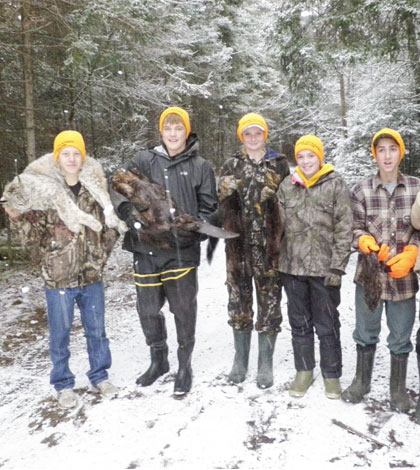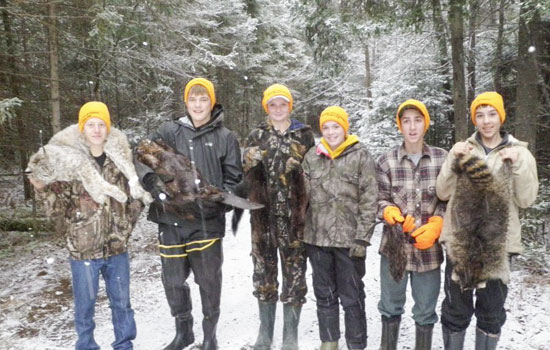My involvement with the trapper’s course was a bit of a fluke. My husband, Neil, volunteered me to chaperone if any girls were interested. Actually, when he first told me a few years ago about Manitoulin Area Stewardship Council’s (MASC) sponsoring kids to take the course I looked at the list and asked, “Why aren’t there any girls taking the course?”
Right up to the scheduled date in November, I wasn’t even sure if I would be needed. John Seabrook, the main organizer, knew he could count on Mackenzie Turner’s participation as her brother had taken the course previously. She recruited her friend Haley Vander Weerden to join us.
So on Wednesday evening, I was busy getting a refresher from Neil on the “what ifs” of being in the bush. What if the generator stops working? What if the side-by-side doesn’t start? What if there is something we haven’t thought of?
On Thursday evening, all the participants met George Hagen (instructor for the course) in Mindemoya. As part of our involvement, we volunteered the use of our fifth wheel trailer and side-by-side UTV. The plan was for the girls and I to stay in the trailer and drive back and forth to the camp. The girls were quite impressed with the accommodations and were very grateful!
George told us to be ready at 5:30 am on Friday morning and he would be there to guide us to the camp. I didn’t sleep well, as I was worried about all the “what ifs.” I didn’t want to be late on the first morning and perpetuate any thought of “girls shouldn’t be trapping!” I’m pleased to say we were on time and ready to go. It was quite the trip in the dark crossing huge puddles, over deep ruts and turning at what seemed like endless forks in the road. I wondered if we would ever find our way back.
We were greeted with hot breakfast and coffee followed by videos with interesting background music. All of the kids were so attentive and respectful; it was every teacher’s dream class! The day involved learning to set traps, watching several animals get skinned, and going out to check traps that were previously set. It was hard to believe that we understood and safely knew how to use the complex looking “contraptions” by the end of the day.
That evening we were surprisingly tired by 8 pm! Our nightly routine consisted of setting up the generator, warming up the trailer, and sending texts home, as we were able to get service out on the main road. My confidence was growing and I was not as worried about our comfort and safety, as the girls were very content. We were not hungry in the least as we ate very well all day at camp.
Shortly after waking up in the morning, the girls were not far behind. We did our morning tasks and set out on our adventure. Working as a team we made our way back to the camp. We were so proud of ourselves for getting there without getting lost! Again, not making a big deal out of our accomplishment, we quietly “high-fived” each other before greeting the boys.
Over the next two days we watched more videos, looked through our binders, asked a ton of questions, skinned, stretched, set and checked traps. We even handled a flat tire! I think our day of skinning was the most tiring. We all watched and then tried our hand at it. At each step, our teachers patiently guided us through the process, which seemed to take most of the day!
On our fourth day, we were able to put our new knowledge and skills to the test. With the sun shining on our backs, we all had to choose two types of trap scenarios and set them up. It was pretty amazing to see all of the students putting their skills to the test. Then with George’s guidance, we all demonstrated our knowledge on a multiple-choice test, all passing with flying colours.
On the drive home, we reflected on our experiences. We talked about how we went from not knowing each other and not knowing what to expect, to how we actually set traps, caught and then skinned an animal. We laughed about how we initially felt pretty nervous about the whole weekend.
Mac and Haley made my chaperone responsibilities very easy. They never complained about their level of comfort; they were always helpful (as were the boys); there were no “grossed-out” giggles or thoughts of “I’m a girl—I can’t do that.” They came to this course as seasoned “outdoors-girls” and I think this experience added to their repertoire of skills.
In retrospect, I am both amazed and proud that people have kept the tradition of trapping alive and well in Ontario. From the heritage standpoint, it is an incredibly important connection and commonality that both First Nation and non-First Nation people share in Canada. I am grateful to MASC and to our teachers to have given the opportunity for us to see and practice that tradition and attempt to keep it alive for years to come in the great outdoors.
Dianne Glasby-Debassige is a special education resource teacher at Lakeview School.






